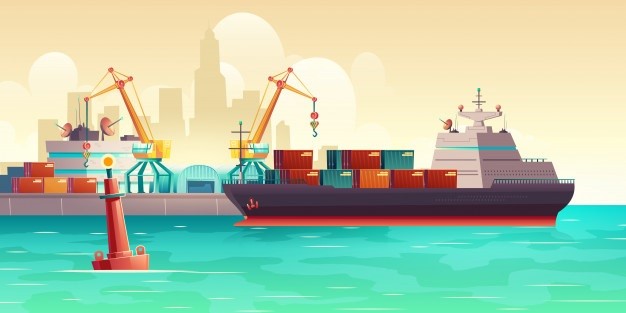Transportation of cargo via containers has restructured international trade. Due to containerization, the cargo is directly filled into the containers at the manufacturing location then transported to the container yard and later on to the port to be loaded onto the ship. This process has greatly facilitated reducing time and safe handling of cargo.
The cargo must reach the final destination undamaged. Any damage or loss of cargo creates a negative impact on your business, increases transportation costs, and damages your relationship with customers. In container shipping, there are many different stakeholders involved in the different phases of the logistics process. With various stakeholders handling various aspects of the supply chain, communication between the parties is difficult and responsibilities or liability are unclear. A few associates who are involved in the handling of the cargo are
- The supplier / manufacturer who loads the cargo
- The local transporter that delivers the cargo to a local warehouse
- The local dray company that moves the cargo from the warehouse to terminal
- The personnel at the port of arrival, discharge, and any transshipment terminal
- The customs or the customs warehouse
- The local transporter involved in the delivery of cargo to the final destination
Cargo damage in container shipping can occur wherever the container is physically handled.
Contents
Causes For Cargo Damage
During an ocean voyage, the ship is subjected to heavy rolling and pitching due to the turbulent waters and bad weather conditions. If the cargo is not secured properly, it will shift. The most common reasons for cargo damage are water damage, impacts that the container took, and damages due to improper container lashing and stuffing.
- Water Damage
Water Damage Occurs Due To The Following Reasons:
- Condensation inside a container, especially if the container is being stuffed at high humidity temperatures. This is because all containers hold moisture to some extent and the high humid air will create condensation as the shipment moves between different climates and the air becomes hotter and colder.
- Constant fluctuations in temperature during the voyage may also increase the condensation inside the container. When the temperature outside of the container drops, the contents within the container cool down causing moisture-absorbing goods, packaging materials, and dunnage used to keep cargo in place within the container to release their water contents. Because the environment inside the container is cold, the vapor is not absorbed by the air and instead condenses along the lining.
- Water may get inside the container if there are any small holes on it, the door sealing gaskets are not in good working condition, or ships hold being flooded.
- Impacts That The Container Took
Cargoes packed inside a container can experience intense longitudinal and transverse forces during transportation and these forces could cause physical damage to the cargo. The worst movement a cargo can face is when transported via sea as a ship can move in six different ways and each of these movements causes a different kind of stress on the cargo packed inside the container. There is a greater chance of damaging the container if there is a movement of cargo inside the container. Bad stowage inside the container is the biggest cause of cargo damage. Bad stowage inside the container is the biggest cause for cargo damage.
- Improper Stuffing And Lashing Of The Container
Shifting cargo, uneven weight distribution, improper loading of the pallets, lack of proper packaging, and poor lashing are some of the common causes of cargo damage. The lack of using the correct type of container, proper dunnage, and container lashing are also contributing factors that lead to cargo damage.
How To Prevent Cargo Damage ?
Before choosing the packaging type and transport mode, it is essential to know and understand the characteristics and distinctiveness of the cargo being packed and what type of damage the cargo may suffer or cause during transit.
- Choosing The Right Container
Containers are available in various dimensions; hence choose the container that best suits the requirements of your cargo. Choose a container type that helps in temperature control or ventilation as temperature increase inside the container will cause damage to the cargo. The container should have proper lashing points of the strength required to secure your cargo. Check the container for any structural damage and residues or contamination left from an earlier shipment.
- Packing Of Cargo Into The Container
Proper lashing, dunnage material, and methods should be used to restrict the movement of the cargo within the container. Shifting cargo and uneven weight distribution are some of the most common causes of cargo damage. Free space in a container increases the risk of cargo shifting. Packaging that fits in exactly will reduce dead space and reduce the cost of dunnage. All loose items must be chocked or lashed.
Few Factors To Consider When Packing Cargo Are :
- Plan the stowage of the cargo in the container
- Distribute the weight equally inside the container
- Avoid loading heavy cargo at one side or one end of the container
- Stow heaviest items on the bottom for stability
- Box, crate, or place on cradle the heavy cargo
- Ensure that incompatible cargo is not mixed in the container
- Ensure that cargo that is susceptible to leakage or spillage is not stowed on top of other cargo
- Observe hazardous packing guidelines
- Proper Container Lashing
Containers when loaded over ships are secured to the ship’s structure and to the container placed below it using lashing rods, turnbuckles, twist-locks, etc. This prevents the containers from moving from their places or falling off into the sea during rough weather or heavy winds. It also helps to ensure minimal cargo damage within the container due to the rough movements of the vessel. Container lashing is important as it is the first thing insurance companies audit in case of an accident.
Cargo damage prevention is very important and working closely with all the stakeholders involved in the supply chain logistics is the only way to ensure your cargo will be on time, on budget, and undamaged.




